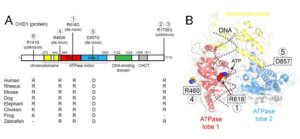CHD1 is a chromatin remodeler which plays a role in ensuring chromatin accessibility across the genome in stem cells. Here we report that novel missense variants in CHD1 are associated with a neurodevelopmental phenotype that includes autism, speech apraxia and hypotonia. CHD1 has not previously been associated with such a phenotype and, interestingly, the location and class of disease causing variants identified in CHD1 suggest a dominant negative mechanism of disease. We are excited about these findings, as they will aid in interpretation of sequencing results of undiagnosed patients as well as potentiate understanding of the contribution of epigenetics to human disease. (By Genay Pilarowski, http://jmg.bmj.com/content/early/2017/09/02/jmedgenet-2017-104759 )
Missense variants identified in CHD1 are associated with a distinct neurological syndrome.
(A) We have identified five unrelated subjects with missense variants at highly conserved locations within the coding region of the CHD1 gene. R = Arginine, K = Lysine, D = Aspartic Acid, G = Glycine, Q = Glutamine. (B) Locations of the de novo missense sites on the chromodomain-ATPase motor, shown on 3-dimensional Chd1 protein structure. Colors represent protein domains and correspond to those in (A). Note that the Arg618Gln variant occurs at the interface between DNA and ATP, supporting the hypothesis that these changes have functional consequences.
